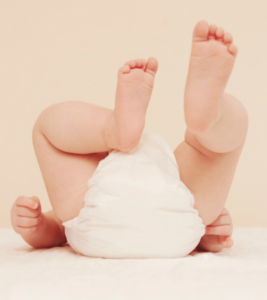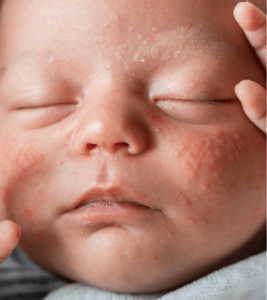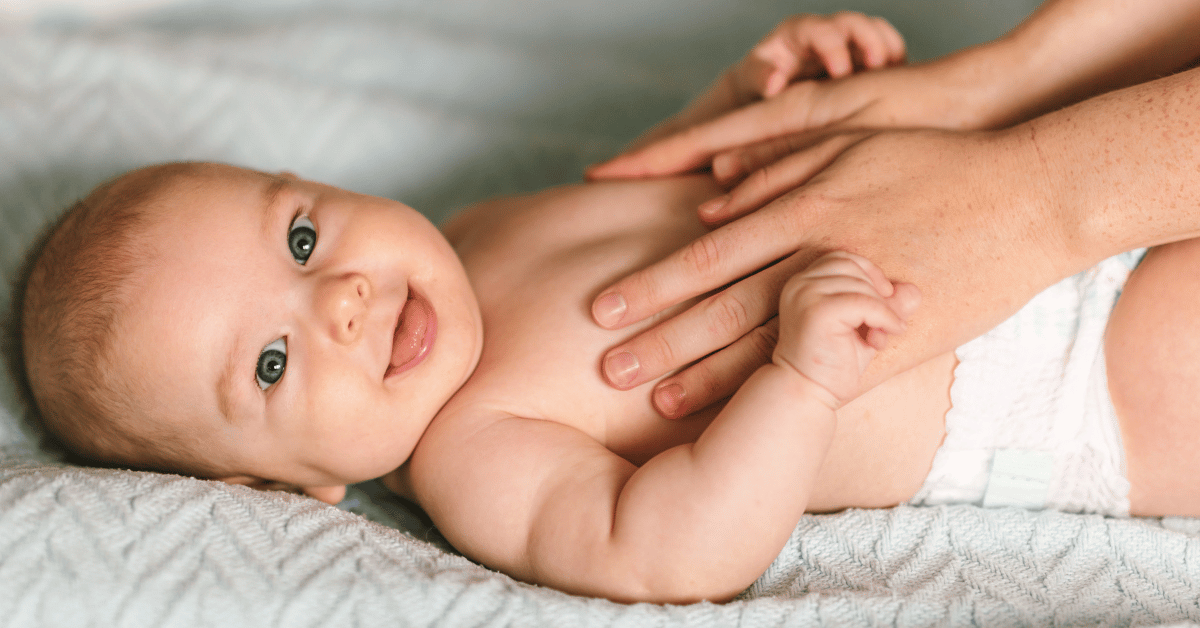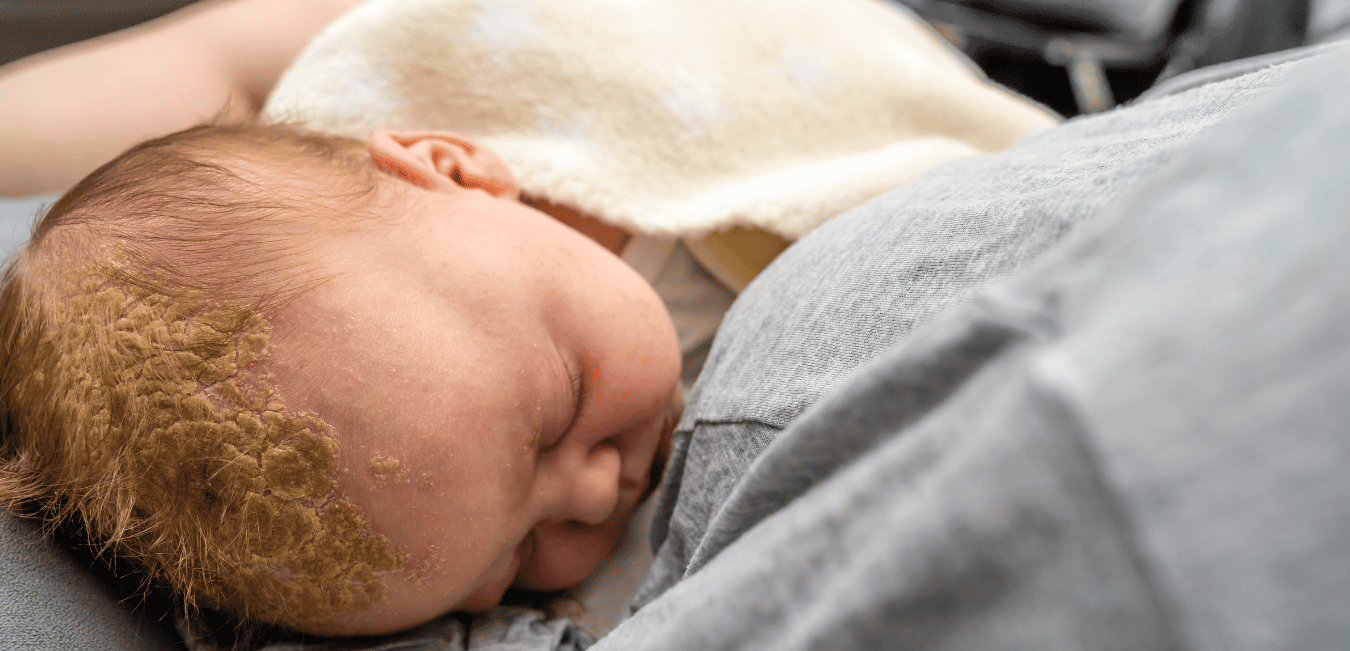Skin conditions in infants are incredibly common. In fact, skin conditions are one of the most likely reasons parents bring their babies to the doctor (1). Most infant skin conditions are benign and will go away without treatment, but occasionally treatment is necessary.
In this article, you will learn about your baby’s skin as well as common infant skin conditions, such as diaper rash, eczema, cradle cap, baby acne, milia, contact dermatitis, erythema toxicum, and transient neonatal pustular melanosis.
To learn more about how to care for your baby’s delicate skin, see: Baby Skincare 101.
The Development of Infant Skin
Skin is an important and complex organ that undergoes many dynamic changes in the first year of a baby’s life in order to perform all of its most important functions, including:
- Acting as a physical barrier between the internal body and the environment
- Filtering UV rays
- Protecting the body against germs
- Regulating body temperature
- Performing sensory perception
During the first year of life there are changes in skin structure, sweating, acidity, moisture levels, and more as newborn skin matures and develops.
For more about newborn skin, see All About Vernix: Should It Be Washed Off?
8 Common Skin Conditions in Babies
Due to changes to the skin during an infant’s first year of life, infants are not only more sensitive to skin barrier disruption and toxicity from topical preparations but also more prone to the following eight skin conditions (2).
1. Diaper Rash (Diaper Dermatitis)
Accounting for more than one million doctor appointments a year, diaper rash is considered to be the most common skin disorder in infants in the United States (1).
Appearing as a flat or raised rash, diaper rash presents with red and inflamed skin in the area covered by the diaper. Unlike some of the other skincare disorders in babies, diaper rash can cause a lot of discomfort for your baby, especially during a diaper change.
 Because diaper rash can be caused by a combination of skin sensitivity, wet or soiled diapers, and chafing, it is important to change your baby’s diaper frequently, avoid using scented wipes or diapers, and gently pat their skin dry instead of wiping. Changing diaper brands or switching to cloth diapers can sometimes be helpful for sensitive infants.
Because diaper rash can be caused by a combination of skin sensitivity, wet or soiled diapers, and chafing, it is important to change your baby’s diaper frequently, avoid using scented wipes or diapers, and gently pat their skin dry instead of wiping. Changing diaper brands or switching to cloth diapers can sometimes be helpful for sensitive infants.
Diaper rash can usually be managed at home by keeping the diaper area clean and dry and using healing salves, ointments, pastes, or creams. If diaper rash doesn’t clear up within 5-7 days, a trip to the doctor is warranted.
2. Eczema (Atopic Dermatitis)
Affecting up to 25% of children, the skin condition eczema causes itchy, inflamed, and dry skin that can ooze or crust over (3). Eczema appears dark brown, purple, or gray on dark skin and red or pink on light skin. Usually located in the creases of the elbows or knees, eczema can also be found in other locations such as on the scalp or cheeks.
Although eczema has no cure, there are ways to help control the flare-ups, which include keeping your baby’s skin moisturized, using topical healing preparations, and identifying and avoiding triggers such as foods, fragrances, and environmental allergens (3).
For more information on eczema, see Eczema Treatment 101.
3. Cradle Cap (Infantile Seborrheic Dermatitis)
Not contagious, yet incredibly widespread, cradle cap is one of the most common skin conditions in infants (4). It often appears as scaly yellow patches on your baby’s scalp. Usually harmless, this skin condition will most likely go away on its own within weeks to months of onset (5).
Though cradle cap will improve on its own, you can help by gently brushing your baby’s scalp or massaging with a small amount of oil before shampooing in order to help loosen the flakes. Avoid picking at the flakes as it may lead to infection.
For more on cradle cap, see How to Treat Cradle Cap.
4. Baby Acne (Neonatal Acne)
Similar to the acne you’d see on a teenager’s face, baby acne presents as small bumps which are believed to be caused by the hormones the baby is exposed to before birth as well as neonatal androgens (6).
Baby acne is commonly noticed around 2 weeks of age and can appear on a baby’s face, scalp, back, and chest. It will go away on its own without leaving any permanent scars, but if any of the bumps look infected it’s best to take your baby to the doctor to get it checked out (7). Bumps from baby acne may appear red or brown depending on underlying skin tone.
Note: Acne after 6 weeks of age is called Infantile acne. This is different from neonatal acne and a visit to a dermatologist may be required (7).
5. Milia
Affecting up to 50% of newborns is the skin condition milia (8). Easily confused with baby acne, milia are tiny white bumps commonly found on your baby’s face — mostly noted on their nose, eyelids, and cheeks. Completely harmless, these little bumps will go away without any treatment within the first month of life, although it may take longer for them to resolve (8).
 If your baby still has milia present after a few months, bring it up to the pediatrician at your next appointment.
If your baby still has milia present after a few months, bring it up to the pediatrician at your next appointment.
6. Contact Dermatitis (Irritant and Allergic)
Babies’ skin is thinner and more absorbent than adults, so when they are in contact with certain irritants or allergens, contact dermatitis can occur causing their skin to be itchy, inflamed, swollen, dry, blistering, bleeding, and more (9).
There are two types of contact dermatitis: irritant and allergic.
Irritant: Irritant contact dermatitis is caused by contact with substances that cause irritation on your baby’s skin. In newborns, a common type of irritant contact dermatitis is diaper rash due to the dampness and prolonged exposure to soiled diapers (see above) (9). Drool rash is another type of irritant contact dermatitis and is caused by the frequent exposure to saliva on the chin and neck.
Allergic: Allergic contact dermatitis is usually brought on by exposure to allergens by way of adults. These allergens include ingredients in cosmetics or exposure to antibiotics and antiseptics (9).
Identifying and avoiding dermatitis triggers can be helpful for treating and preventing contact dermatitis.
7. Erythema Toxicum
Affecting up to 72% of full-term infants, erythema toxicum appears on the skin as small, pus-filled yellowish bumps on a red wheal, similar to a small hive. On darker skin, the redness may be hard to see. Only seen in newborns, this skin condition has been linked to a reaction to meconium. Although the name makes it sound serious, erythema toxicum is benign and will most likely resolve in 7-14 days without intervention (10).
8. Transient Neonatal Pustular Melanosis
Another skin condition that will resolve on its own, transient neonatal pustular melanosis is not as common as the other skin conditions mentioned above. In America, it is most common in full term black infants — with an incidence of 4.4% in black infants compared to 0.6% in white infants and an overall rate of 2.2%. Literature about its incidence in other races is sparse (11, 12).
Appearing at birth as small pus-filled spots on various areas of the body, such as the forehead, neck, chest, lower back, and thighs, transient neonatal pustular melanosis will usually disappear within 5-14 days after birth without any intervention. Hyperpigmented spots may appear after the pustules heal and may persist for several months (12).
Although there is no known cause to this skin condition, it is considered to be harmless.
Summary
From rashes to acne, your baby’s skin is prone to different skin conditions in the first year of life due to its sensitivity and delicacy. By being aware of different skin conditions and ways to support your baby’s skin, you can help your baby feel their best and provide yourself with the knowledge it takes to support them.
References
- Nield, L. S., & Kamat, D. (2007). Prevention, Diagnosis, and Management of Diaper Dermatitis. Clinical Pediatrics, 46(6), 480–486. https://doi.org/10.1177/0009922806292409
- Oranges, T., Dini, V., & Romanelli, M. (2015). Skin Physiology of the Neonate and Infant: Clinical Implications. Advances in wound care, 4(10), 587–595. https://doi.org/10.1089/wound.2015.0642
- American Academy of Dermatology. (n.d.). How to treat eczema in babies. Www.aad.org. https://www.aad.org/public/diseases/eczema/childhood/treating/treat-babies
- Elish, D., & Silverberg, N. (2006). Infantile Seborrheic Dermatitis CONTINUING MEDICAL EDUCATION. 77, 297. https://cdn.mdedge.com/files/s3fs-public/Document/September-2017/077050297.pdf
- Victoire, A., Magin, P., Coughlan, J., & van Driel, M. L. (2019). Interventions for infantile seborrhoeic dermatitis (including cradle cap). The Cochrane database of systematic reviews, 3(3), CD011380. https://doi.org/10.1002/14651858.CD011380.pub2
- Godínez-Chaparro, J. A., & Cruz, H. V. (2021). Acné en el recién nacido [Acne in the newborn.]. Boletin medico del Hospital Infantil de Mexico, 78(5), 443–449. https://doi.org/10.24875/BMHIM.20000327
- American Academy of Dermatology. (n.d.). Is that acne on my baby’s face? Www.aad.org. https://www.aad.org/public/diseases/acne/really-acne/baby-acne
- Gallardo Avila, P. P., & Mendez, M. D. (2020). Milia. PubMed; StatPearls Publishing. https://www.ncbi.nlm.nih.gov/books/NBK560481/
- Pigatto, P. P., Martelli, A. A., Marsili, C. C., & Fiocchi, A. A. (2010). Contact dermatitis in children. Italian Journal of Pediatrics, 36(1), 2. https://doi.org/10.1186/1824-7288-36-2
- Roques, E., & Mendez, M. D. (2020). Erythema Toxicum. PubMed; StatPearls Publishing. https://www.ncbi.nlm.nih.gov/books/NBK470222/
- Chia, P.-S., Leung, C., Hsu, Y.-L., & Lo, C.-Y. (2010, January 15). An Infant With Transient Neonatal Pustular Melanosis Presenting as Pustules. https://www.pediatr-neonatol.com/article/S1875-9572(10)60069-1/pdf
- Kutlubay, Z., Tanakol, A., Engyn, B.., Onel, C., Symsek, E., Serdaroglu, S., Tuzun, Y., Yilmaz, E., & Eren, B. (2017). Newborn Skin: Common Skin Problems. Mædica, 12(1), 42–47. https://www.ncbi.nlm.nih.gov/pmc/articles/PMC5574071/







